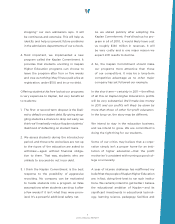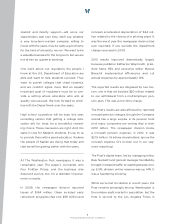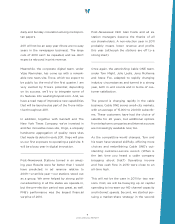Washington Post 2010 Annual Report Download - page 19
Download and view the complete annual report
Please find page 19 of the 2010 Washington Post annual report below. You can navigate through the pages in the report by either clicking on the pages listed below, or by using the keyword search tool below to find specific information within the annual report.Title IV Eligibility and Compliance With Title IV Program Requirements. To maintain eligibility to participate in Title IV
programs, a school must comply with extensive statutory and regulatory requirements relating to its financial aid
management, educational programs, financial strength, administrative capability, compensation practices, facilities,
recruiting practices and various other matters. In addition, the school must be licensed or otherwise legally authorized to
offer postsecondary educational programs by the appropriate governmental body in the state or states in which it is
physically located, be accredited by an accrediting agency recognized by the U.S. Department of Education (the
“Department of Education”) and be certified to participate in the Title IV programs by the Department of Education.
Schools are required periodically to apply for renewal of their authorization, accreditation or certification with the
applicable state governmental bodies, accrediting agencies and the Department of Education. In accordance with
Department of Education regulations, some Kaplan Higher Education schools are combined into groups of two or more
schools for the purpose of determining compliance with certain Title IV requirements, and each such group is assigned its
own identification number, known as an OPEID number. As a result, the schools in Kaplan’s Higher Education division
have a total of 33 OPEID numbers. No assurance can be given that the Kaplan schools, or individual programs within
schools, will maintain their Title IV eligibility, accreditation and state authorization in the future or that the Department of
Education might not successfully assert that one or more of such schools have previously failed to comply with Title IV
requirements.
The Department of Education may place a school on provisional certification status under certain circumstances, including,
but not limited to, failure to satisfy certain standards of financial responsibility or administrative capability or upon a
change in ownership resulting in a change of control. Provisional certification status carries fewer due process protections
than full certification. As a result, the Department of Education may withdraw an institution’s provisional certification more
easily than if it were fully certified. In addition, the Department of Education may subject an institution on provisional
certification status to greater scrutiny in some instances, for example, when it applies for approval to add a new location
or program or makes another substantive change. Provisional certification does not otherwise limit access to Title IV
program funds by students attending the institution. Currently, one Kaplan Higher Education reporting unit is provisionally
certified.
In addition, the Department of Education may fine a school, require a school to repay Title IV program funds, limit or
terminate a school’s eligibility to participate in the Title IV programs, initiate an emergency action to suspend the school’s
participation in the Title IV programs without prior notice or opportunity for a hearing, transfer a school to a method of
Title IV payment that would adversely affect the timing of the institution’s receipt of Title IV funds, deny or refuse to consider
a school’s application for renewal of its certification to participate in the Title IV programs, refer a matter for possible civil
or criminal investigation or take other enforcement measures if it finds that the school has failed to comply with Title IV
requirements or improperly disbursed or retained Title IV program funds. There can be no assurance that the Department
of Education will not take any of these actions in the future, whether as a result of a lawsuit, Program Review or otherwise.
This list is not exclusive. There may be other actions the Department of Education may take and other legal theories under
which a school could be sued as a result of alleged irregularities in the administration of student financial aid. See Item
1A. Risk Factors, including “Failure to Comply With Statutory and Regulatory Requirements Could Result in Loss of Access
to U.S. Federal Student Loans and Grants Under Title IV, a Requirement to Pay Fines or Monetary Liabilities or Other
Sanctions.”
Student Default Rates. A school may lose its eligibility to participate in Title IV programs if student defaults on the
repayment of Title IV loans exceed specified rates, referred to as “cohort default rates.” The Department of Education
calculates a cohort default rate for each of Kaplan Higher Education’s OPEID numbers. The schools in an OPEID number
whose cohort default rate exceeds 40% for any single year lose their eligibility to participate in the Federal Family
Education Loan (“FFEL”) and Direct Loan programs effective 30 days after notification from the Department of Education
and for at least two fiscal years, except in the event of a successful adjustment or appeal. The schools in an OPEID
number whose cohort default rate equals or exceeds 25% for three consecutive years lose their Title IV eligibility to
participate in FFEL, Direct Loan and Federal Pell Grant programs effective 30 days after notification from the Department
of Education and for at least two fiscal years, except in the event of a successful adjustment or appeal. The schools in an
OPEID number whose cohort default rate equals or exceeds 25% in any one of the three most recent fiscal years for
which rates have been issued by the Department of Education may be placed on provisional certification by the
Department of Education.
The enactment in August 2008 of the Higher Education Opportunity Act (which reauthorized the Federal Higher
Education Act) changed the methodology that will be used to calculate cohort default rates for future years. Under the
revised law, the period of time for which student defaults are tracked and included in the cohort default rate calculation is
extended by a year, which is expected to increase the cohort default rates for most institutions. That change became
2010 FORM 10-K 3
























